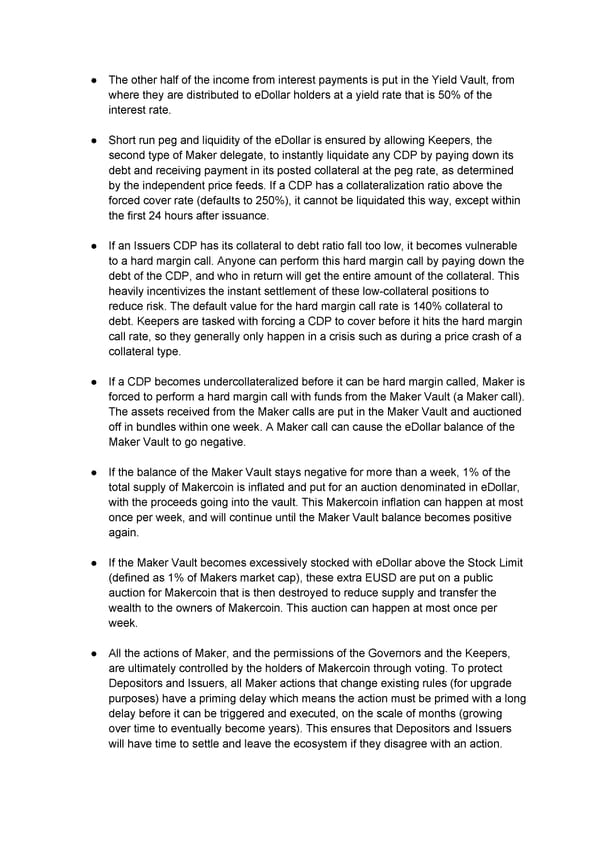● The other half of the income from interest payments is put in the Yield Vault, from where they are distributed to eDollar holders at a yield rate that is 50% of the interest rate. ● Short run peg and liquidity of the eDollar is ensured by allowing Keepers, the second type of Maker delegate, to instantly liquidate any CDP by paying down its debt and receiving payment in its posted collateral at the peg rate, as determined by the independent price feeds. If a CDP has a collateralization ratio above the forced cover rate (defaults to 250%), it cannot be liquidated this way, except within the first 24 hours after issuance. ● If an Issuers CDP has its collateral to debt ratio fall too low, it becomes vulnerable to a hard margin call. Anyone can perform this hard margin call by paying down the debt of the CDP, and who in return will get the entire amount of the collateral. This heavily incentivizes the instant settlement of these lowcollateral positions to reduce risk. The default value for the hard margin call rate is 140% collateral to debt. Keepers are tasked with forcing a CDP to cover before it hits the hard margin call rate, so they generally only happen in a crisis such as during a price crash of a collateral type. ● If a CDP becomes undercollateralized before it can be hard margin called, Maker is forced to perform a hard margin call with funds from the Maker Vault (a Maker call). The assets received from the Maker calls are put in the Maker Vault and auctioned off in bundles within one week. A Maker call can cause the eDollar balance of the Maker Vault to go negative. ● If the balance of the Maker Vault stays negative for more than a week, 1% of the total supply of Makercoin is inflated and put for an auction denominated in eDollar, with the proceeds going into the vault. This Makercoin inflation can happen at most once per week, and will continue until the Maker Vault balance becomes positive again. ● If the Maker Vault becomes excessively stocked with eDollar above the Stock Limit (defined as 1% of Makers market cap), these extra EUSD are put on a public auction for Makercoin that is then destroyed to reduce supply and transfer the wealth to the owners of Makercoin. This auction can happen at most once per week. ● All the actions of Maker, and the permissions of the Governors and the Keepers, are ultimately controlled by the holders of Makercoin through voting. To protect Depositors and Issuers, all Maker actions that change existing rules (for upgrade purposes) have a priming delay which means the action must be primed with a long delay before it can be triggered and executed, on the scale of months (growing over time to eventually become years). This ensures that Depositors and Issuers will have time to settle and leave the ecosystem if they disagree with an action.
 Maker eDollar Page 2 Page 4
Maker eDollar Page 2 Page 4